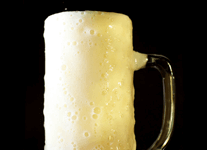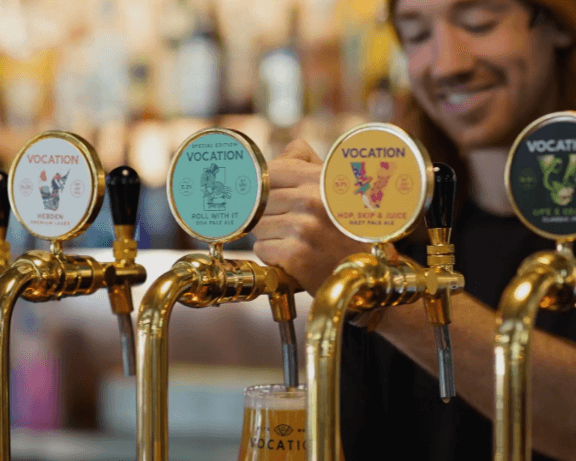Lesson 8: How to Store Beer
Now that we've mastered the art of the perfect pour, let's backtrack a little bit and talk about how that delicious beer you're enjoying should be taken care of before it gets to your glass. Some beers are perfect for aging and some should be enjoyed as fresh as possible. So what's what?
Which Beers Can Be Cellared?
Generally speaking, beers with lots of hops--IPAs, Pale Ales, Bitters and the like--should be consumed as quickly as possible. The flavours and character from the hops deteriorate quickly and if not polished off soon you'll be left with a malty, stale beverage. Certainly not what the brewer wanted you to taste! Lagers too: there's not a whole lot of change that will happen within a lager once it's been bottled so go ahead and drink that fresh and cold. Finally, wheat beers could do with a quick drink as well or else the proteins from the wheat will start to drop out and you could be left with a dud.
Drink IPAs, Pale Ales, Bitters, English Stouts, Lagers and most Wheat Beers as fresh as possible.
On the other hand, some beers would do better with a little bit of time in the cellar: beers with high ABVs (8% and above), sour beers, barrel-aged, bottle-conditioned beers (but not your lower-ABV Real Ales) and even some smoked beers are best suited. With some time in the cellar you'll find that the flavours and mouthfeel in your Barleywines, Russian Imperial Stouts, Quadrupels, Scotch Ales, Gueuzes, Goses and Lambics will be more refined and smoother. The cellaring process allows flavours to meld, alcohol harshness to be tamed and tartness to become more subdued. The character of these beers can continue to change for years to come!
Barleywines, Russian Imp Stouts, Quadrupels, Scotch Ales and Sour/Wild Ales would do well with a bit of time in the cellar.
Some styles, like Saisons--especially those with Brettanomyces--Oatmeal or Sweet Stouts and Berliner Weisses don't necessarily need time in the cellar but your patience can be rewarded if you give them a little time to sit before enjoying them. These styles are historically intended to be enjoyed fresh but go ahead and see what happens if you wait a bit--you could be pleasantly surprised!
Saisons, Berliner Weisses and some Sweet/Oatmeal Stouts can be stored for a bit but don't wait too long.
As with most things in the beer world, cellaring and aging your beers is all about experimentation. Don't know how your Saison will taste after a year? Stick one in your cellar and find out. Want to see how your Barleywine changes over time? Buy five and do your own vertical tasting at home. Can't wait to drink that Wet Hop IPA? Well, don't--drink it fresh!
What's a Vertical Tasting?
A vertical tasting is when you taste one beer with samples from different years. For example, during a vertical tasting you can compare a Sierra Nevada Bigfoot Barleywine that was brewed in 2005 next to those from 2006, 2007, 2008 and so on. It requires patience and proper cellaring but when done well it is an exciting way to experience the evolution of a particular beer in the cellar.
How to Keep Your Beer
Now that we know which beer styles are and are not suitable for aging, how exactly should we store our stash? While cellaring and aging your beers isn't necessarily an exact science refer to our handy chart to see our best recommendations to ensure delicious beer:
| Beer Style | Cellar Temperature | Max Length of Cellar Time |
|---|---|---|
| American IPA | 4-7C | 2-6 months |
| English IPA | 2-4C | 2-6 months |
| Imperial/Double IPA | 7-10C | 2-6 months |
| American Pale Ale | 2-4C | 2-6 months |
| English Bitter/English Pale Ale | Do Not Cellar | N/A |
| Belgian Pale Ale | 4-7C | 2-6 months |
| Saison | 7-10C | Up to 1 year |
| Belgian Dubbel | 7-10C | Up to 2 years |
| Belgian Tripel | 7-10C | Up to 2 years |
| Belgian Quadrupel | 7-10C | Up to 10 years |
| Witbier | 4-7C | 2-6 months |
| Weissbier/Hefeweizen | 4-7C | 2-6 months |
| Altbier | 4-7C | 2-6 months |
| Kölsch | 2-4C | 2-6 months |
| English Porter | Do Not Cellar | N/A |
| American Porter | 4-7C | Up to 1 year |
| Stout | Do Not Cellar | N/A |
| Oatmeal/Milk/Sweet Stout | 4-7C | 2 months-1 year |
| Russian Imperial Stout | 7-10C | Up to 10 years |
| Barleywine | 7-10C | Up to 20 years |
| Wee Heavy/Scotch Ale | 4-7C | Up to 20 years |
| American Amber/Red Lager | 2-4C | 2-6 months |
| California Common/Steam Beer | 2-4C | 2-6 months |
| Czech/Bohemian Pilsner | 2-4C | 2-6 months |
| Bock/Doppelbock/Maibock | 4-7C | 2-6 months |
| Munich Helles | 2-4C | 2-6 months |
| German Pilsener | 4-7C | 2-6 months |
| Märzen/Oktoberfest | 4-7C | 2-6 months |
| Rauchbier | 4-7C | 2-6 months |
| Gose | 4-7C | Up to 10 years |
| Berliner Weisse | 4-7C | Up to 1 year |
| Gueuze | 7-10C | Up to 20 years |
| Fruit Lambic | 7-10C | Up to 20 years |
Breweries package their beer in many types of containers: cans, traditional bottles, bottles with corks and swing tops. Some beers have been filtered but are live while some are bottle-conditioned and still have sediment in the bottom. When it comes to cellaring your beer in whatever packaging it comes in, it's recommended to store it upright as opposed to horizontally like wine. This ensures a smaller surface area that could be exposed to oxygen and slows down possible oxidation of a beer. Also, if there is any sediment in a beer storing it upright meakes sure that it stays in the bottom of the bottle and won't develop a yeast ring on the side of the bottle which won't come off. Even corked beer should be fine stored upright but some experts do recommend storing it on its side so we'll leave that judgment call up to you.
When storing beer all packaging types should be stored in an upright position.
How to Make a Cellar
Not everybody has the luxury of their own beer cellar at home. Here are the very basics that you need in order to store your beer as well as possible:
A Cool Area
Choose a room or area in your house that maintains a relatively constant temperature at about 10-13C. If you've got a basement, you're in luck, but whatever you do, keep it away from those radiators or other heat sources. Remember, televisions and electronics can really heat up a room!
Dark
Light, especially UV light and flourescent lighting, is one of beer's biggest enemies.
Slightly Humid
This will help with any bottles with corks. Notice we didn't say damp, though. Damp areas are prime locations for bacterias and other icky things. Those can seep into your bottled beers and spoil it.
Invest in a Wine Refrigerator
A wine refrigerator is all of those things! Many have glass-front doors so make sure that they're rated for keeping out UV rays. Just swap out the slotted shelving for some solid ones so that it's easier for you to prop your beers upright.
It's worth noting that wine refrigerators are susceptible to ambient temperature so it's still recommended to keep them in a cool, stable environment.
Invest in a Refrigerator Refrigerator
Finally, you'll notice that some beers like to be served at cellar temperature while others (like lagers) like to be served colder. It's nigh impossible to have enough temperature zones in one room or even in your wine refrigerator. So if your cellar temperature is warmer than what some beers want to be served at, pop those beers into the refrigerator when it's getting closer to time to serve them. Go ahead and keep your lagers in the refrigerator but it's not advised to keep other beers in there long term as its dry environment is not necessarily suitable for aging.
Great reading this week, everybody! That's a lot of information to take in. We now know how to properly store beer. Next week we'll discuss some things to think about when it comes to packaging. We'll taste beer again before the end of the unit but after that, it's quiz time!





